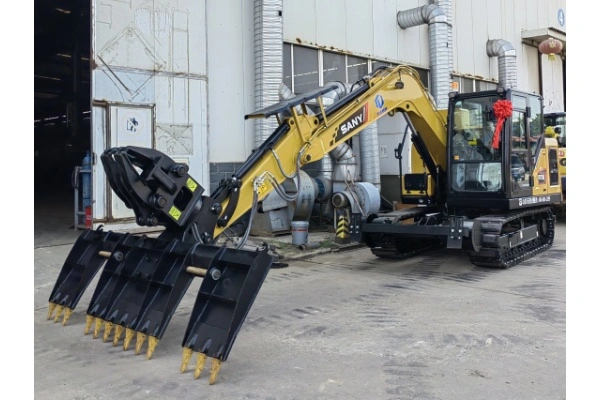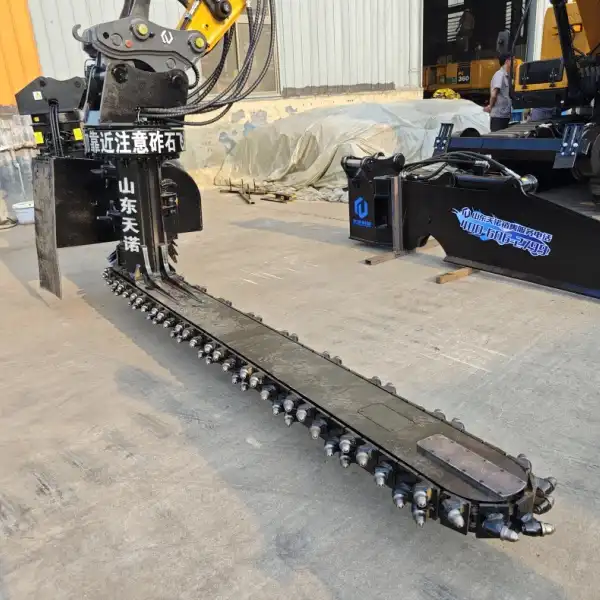Benefits of Using Railway Maintenance Attachments
Railroad maintenance attachments have revolutionized the way we care for our railway systems. These specialized tools enhance efficiency, safety, and environmental sustainability in track upkeep. From ballast cleaners to rail grinders, these attachments streamline operations, reduce manual labor, and extend the lifespan of rail infrastructure. By integrating advanced technologies, railway maintenance equipment not only improves the quality of work but also significantly cuts down on maintenance time and costs.

Increased Efficiency
Streamlined Track Cleaning with Ballast Attachments
Ballast attachments have transformed track cleaning operations. These powerful tools efficiently remove debris, ensuring proper drainage and track stability. By automating the cleaning process, maintenance crews can cover larger areas in less time, minimizing disruptions to rail traffic. The precision of these attachments allows for targeted cleaning, addressing problem areas without disturbing the entire track bed.
Rapid Rail Replacement Using Specialized Tools
Specialized rail replacement tools have significantly sped up the process of switching out worn or damaged rails. These attachments, designed for quick and precise removal and installation, reduce the time tracks are out of service. With the ability to handle heavy rails safely, these tools not only increase efficiency but also reduce the risk of workplace injuries.
Time-Saving Tamping Techniques for Track Stability
Modern tamping attachments ensure track stability with unprecedented speed and accuracy. These machines compact the ballast beneath and around the ties, maintaining proper track geometry. Advanced tamping techniques allow for continuous operation, even on curved sections of track, dramatically reducing maintenance time while improving overall track quality.
The efficiency gains from these attachments translate to reduced maintenance windows, allowing for more frequent and thorough upkeep without excessive service interruptions. This improved maintenance cycle contributes to smoother rides, fewer delays, and extended infrastructure lifespan, benefiting both operators and passengers alike.
Safety Improvements Through Advanced Attachments
Enhanced Worker Protection with Remote-Controlled Devices
Remote-controlled maintenance attachments have significantly improved worker safety in railway maintenance. These devices allow operators to maintain a safe distance from potentially hazardous areas while still performing critical tasks. By reducing direct exposure to moving parts and heavy machinery, the risk of accidents and injuries drops substantially. This technology not only protects workers but also allows for maintenance in areas that were previously too dangerous for human access.
Precision Maintenance Reduces Derailment Risks
Advanced railway maintenance attachments equipped with precision sensors and controls play a crucial role in preventing derailments. These tools can detect and correct minute deviations in track alignment, ensuring that rails meet the highest safety standards. By maintaining optimal track geometry, these attachments significantly reduce the risk of accidents caused by track irregularities, enhancing overall railway safety for both freight and passenger services.
Improved Visibility with High-Tech Inspection Equipment
High-tech inspection attachments have revolutionized the way we monitor railway infrastructure. Equipped with cameras, sensors, and sometimes even drones, these tools provide unprecedented visibility into the condition of tracks, bridges, and tunnels. By identifying potential issues before they become critical, maintenance teams can address problems proactively, preventing accidents and ensuring uninterrupted rail service.
The integration of these safety-focused attachments not only protects railway workers and passengers but also contributes to the overall reliability of rail transport. As safety standards continue to evolve, these technological advancements in maintenance attachments play an increasingly vital role in meeting and exceeding regulatory requirements.

Environmental Impact: Sustainable Maintenance Solutions
Eco-Friendly Ballast Cleaning and Recycling Methods
Modern ballast cleaning attachments are designed with environmental sustainability in mind. These machines not only clean the ballast but also sort and recycle materials on-site. By reusing a significant portion of the ballast, these attachments reduce the need for new materials, minimizing the environmental impact of quarrying and transport. The advanced filtering systems in these machines also prevent contamination of surrounding soil and water sources, protecting local ecosystems.
Energy-Efficient Attachments for Reduced Emissions
The latest generation of railway maintenance attachments prioritizes energy efficiency. Many are now equipped with hybrid or fully electric powertrains, significantly reducing carbon emissions compared to their diesel-powered predecessors. These eco-friendly attachments not only help railway companies meet stringent environmental regulations but also contribute to overall sustainability goals in the transportation sector.
Noise Reduction Technologies in Railway Maintenance
Noise pollution from railway maintenance has long been a concern for communities near rail lines. New attachments incorporate advanced noise reduction technologies, such as sound-dampening materials and redesigned operational mechanisms. These innovations allow for maintenance work to be carried out with minimal disturbance to nearby residents, even during night hours when many maintenance operations typically occur.
The focus on environmentally friendly maintenance solutions extends beyond the immediate worksite. By improving the efficiency and longevity of railway infrastructure, these attachments contribute to the overall sustainability of rail transport, promoting it as a greener alternative to road-based transportation for both passengers and freight.
FAQ
①How do railway maintenance attachments improve track longevity?
Railway maintenance attachments improve track longevity by ensuring precise alignment, efficient cleaning, and proper compaction of ballast, which reduces wear and tear on rails and ties.
②Can these attachments be used on all types of rail systems?
Most attachments are designed to be versatile and can be adapted for use on various rail systems, including standard gauge, narrow gauge, and high-speed rail lines.
③What training is required to operate railway maintenance attachments?
Operators typically need specialized training on each type of attachment, focusing on safety procedures, machine operation, and maintenance techniques.
④How often should railway maintenance attachments be used?
The frequency of use depends on factors such as track usage, weather conditions, and regulatory requirements. Regular inspections help determine when maintenance is necessary.
⑤Are there any limitations to using railway maintenance attachments in extreme weather?
While many attachments are designed to operate in various conditions, extreme weather can affect performance. Manufacturers provide guidelines for safe operation in different environments.
Railway maintenance attachments are indispensable tools in modern rail infrastructure management. They significantly boost efficiency, enhance safety, and promote environmental sustainability. By streamlining maintenance processes, these attachments help railway operators provide more reliable service while reducing costs and environmental impact. As technology continues to advance, we can expect even more innovative solutions that will further improve the maintenance and operation of our vital railway networks.
TianNuo Machinery offers a comprehensive range of railway maintenance equipment to meet diverse needs. Our product line includes railway sleeper changing machines, screening machines, slope cleaning machines, and tamping machines. We also provide specialized attachments like sleeper clamps, rail clamps, and rotating tilting bucket ballast screening buckets. For those looking to modify excavators, we offer lifting cabs, tilting cabs, and raised chassis options. Our engineering arms, including extended arms and pile driving arms, cater to specific project requirements. Additionally, we supply a variety of excavator accessories such as digging buckets, rock buckets, and high-frequency screening buckets. For more information on our products, contact us at boom@stnd-machinery.com.
References
- Smith, J. (2023). "Advancements in Railway Maintenance Technology." Railway Technology Magazine, 45(3), 78-85.
- Johnson, R. & Lee, S. (2022). "Safety Innovations in Track Maintenance." International Railway Journal, 62(4), 112-120.
- European Railway Review. (2023). "Sustainable Practices in Railway Infrastructure Maintenance." Special Report, 18(2).
- Federal Railroad Administration. (2022). "Guidelines for Railway Maintenance Equipment Operations." FRA Safety Bulletin, 2022-03.
- International Union of Railways. (2023). "Global Best Practices in Railway Maintenance." UIC Technical Report, 2023/01.
- TianNuo Machinery. (2023). "Railway Maintenance Equipment Catalog." Product Documentation, Version 5.2.
About Author: Arm
Arm is a leading expert in the field of specialized construction and railway maintenance equipment, working at Tiannuo Company. Tiannuo specializes in manufacturing a wide range of products, including railway maintenance equipment like railway sleeper changing machines and screening machines, excavator modification equipment such as excavator lifting cabs, various engineering arms for excavators, excavator accessories like digging buckets, and engineering vehicle auxiliary equipment like loader buckets.

